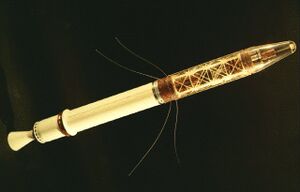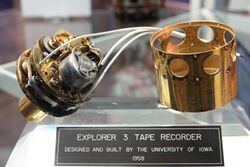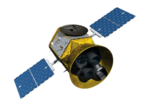Astronomy:Explorer 3
 Photograph of the nearly identical Explorer 1 | |
| Mission type | Earth science |
|---|---|
| Operator | Army Ballistic Missile Agency (ABMA) |
| Harvard designation | 1958 Gamma 1 |
| COSPAR ID | 1958-003A |
| SATCAT no. | 00006 |
| Mission duration | 93 days |
| Spacecraft properties | |
| Manufacturer | Jet Propulsion Laboratory |
| Launch mass | 14.1 kilograms (31 lb) |
| Start of mission | |
| Launch date | March 26, 1958, 17:31 UTC |
| Rocket | Juno I RS-24 |
| Launch site | Cape Canaveral Air Force Station Cape Canaveral Air Force Station Launch Complex 5 |
| End of mission | |
| Decay date | June 27, 1958 |
| Orbital parameters | |
| Reference system | Geocentric |
| Regime | Medium Earth |
| Semi-major axis | 7,870.7 kilometers (4,890.6 mi) |
| Eccentricity | 0.165894 |
| Perigee altitude | 186 kilometers (116 mi) |
| Apogee altitude | 2,799 kilometers (1,739 mi) |
| Inclination | 33.38 degrees |
| Period | 115.7 minutes |
| Epoch | 26 March 1958 |
Explorer program | |
Explorer 3 (international designation 1958 Gamma) was an artificial satellite of the Earth, nearly identical to the first United States artificial satellite Explorer 1 in its design and mission. It was the second successful launch in the Explorer program.
Mission
The satellite was launched from Cape Canaveral Air Force Station , Florida at 17:31:00 UTC on March 26, 1958 by the Juno I vehicle.[1] The Juno I had its origins in the United States Army's Project Orbiter in 1954. The project was canceled in 1955 when the decision was made to proceed with Project Vanguard.
Following the launch of the Soviet Sputnik 1 on October 4, 1957, Army Ballistic Missile Agency (ABMA) was directed to proceed with the launching of a satellite using the Jupiter-C which had already been flight-tested in nose-cone re-entry tests for the Jupiter IRBM (intermediate-range ballistic missile). Working closely together, ABMA and JPL completed the job of modifying the Jupiter-C to the Juno I and building the Explorer I in 84 days.
Spacecraft design
Explorer 3 was launched in conjunction with the International Geophysical Year (IGY) by the U.S. Army (Ordnance) into an eccentric orbit. The objective of this spacecraft was a continuation of experiments started with Explorer 1. The payload consisted of a cosmic ray counter (a Geiger-Müller tube) and a micrometeorite detector (a wire grid array and acoustic detector). The Explorer 3 spacecraft was spin-stabilized and had an on-board tape recorder to provide a complete radiation history for each orbit. It was discovered soon after launch that the satellite was in a tumbling motion with a period of about 7 seconds. Explorer 3 decayed from orbit on June 27, 1958, after 93 days of operation.
Mission results
The discovery of the Van Allen radiation belt by the Explorer satellites was considered to be one of the outstanding discoveries of the IGY.
Explorer 3 was placed in an orbit with a perigee of 186 kilometers and an apogee of 2799 kilometers having a period of 115.7 minutes. Its total weight was 14.1 kilograms, of which 8.4 kg was instrumentation. The instrument section at the front end of the satellite and the empty scaled-down fourth-stage rocket casing orbited as a single unit, spinning around its long axis at 750 revolutions per minute.
Instrumentation consisted of a cosmic ray detection package and a ring of micrometeorite erosion gauges. The Explorer 3 spacecraft was spin-stabilized and had an on-board tape recorder to provide a complete radiation history for each orbit. Data from these instruments was transmitted to the ground by a 60 milliwatt transmitter operating on 108.03 MHz and a 10 milliwatt transmitter operating on 108.00 MHz.
Transmitting antennas consisted of two fiberglass slot antennas in the body of the satellite itself. The four flexible whip antennas of Explorer 1 were removed from the design.[2]
The external skin of the instrument section was painted in alternate strips of white and dark green to provide passive temperature control of the satellite. The proportions of the light and dark strips were determined by studies of shadow-sunlight intervals based on firing time, trajectory, orbit, and inclination.
Electrical power was provided by Mallory type RM Mercury cells that made up approximately 40 percent of the payload weight. These provided power that operated the high power transmitter for 31 days and the low-power transmitter for 105 days.
Because of the limited space available and the requirements for low weight, the Explorer 3 instrumentation was designed and built with simplicity and high reliability in mind. It was completely successful.
Explorer 3 decayed from orbit on June 27, 1958, after 93 days of operation.
A replica of the spacecraft is currently located in the Smithsonian Institution's National Air and Space Museum, Milestones of Flight Gallery.
See also
References
- ↑ "About the Mission". JPL. https://www.jpl.nasa.gov/missions/explorer-3/.
- ↑ Pilkington, W. C. (September 5, 1958). "Vehicle Motions as Inferred from Radio-signal- Strength Records". JPL. https://ntrs.nasa.gov/search.jsp?R=19650073999.
External links
- Data Sheet, Department of Astronautics, National Air and Space Museum, Smithsonian Institution.



